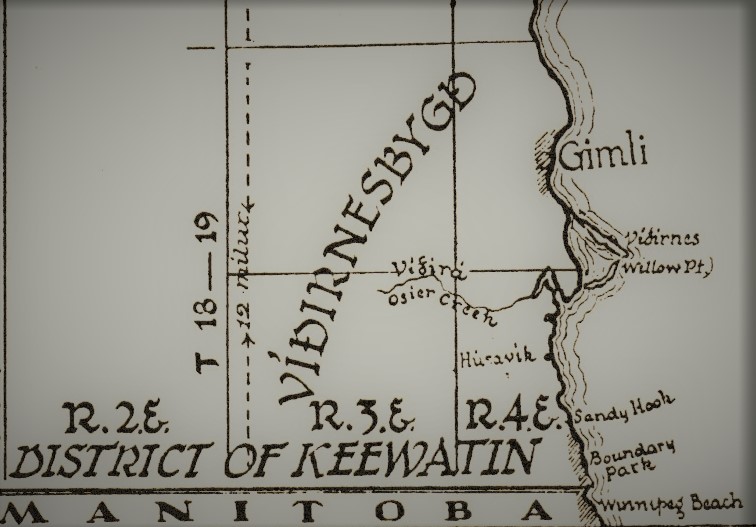
The map shows how Víðirnes juts out into the lake and Gimli north of there. The border between New Iceland and Manitoba before 1881 can be seen. To the south is Winnipeg Beach, where a railway was built in 1902 and then extended north to Gimli in 1906.
The Víðirnes Settlement (Víðirnesbyggð) is the southernmost settlement in New Iceland. It is named after a point that juts out into the water and there the first settlers of New Iceland landed in 1875. The capital of New Iceland, Gimli, was built in the settlement and the first houses were built there the same year in the autumn. A year later, a large group came from Iceland and settlers now spread across the settlements and north along the shore. The land by the lake is hard, sandy, wet and wooded. Víðirnes has low-growing vegetation, at the top of the area is today a fairly dense summer settlement, but people did not settle there in the 19th century. Not far from the lake, farmers wrestled with agriculture, had animals and tried growing grain. Here, as in other settlements of New Iceland, the pioneer years were difficult for many. There were no cows when the first group settled in 1875, and during the winter many died of scurvy. There were no jobs available, so men left the colony the first spring and got a job in Winnipeg or with farmers near the city. There was hardly any progress in the settlement. The struggle in the settlement continued, in the autumn of 1876 smallpox broke out which spread rapidly over the settlement, and many died. At the turn of the year 1877-78, it was clear that the majority of the inhabitants of New Iceland were giving up and wanted something else. In the early spring, people began to move away and seek better places, some going to N. Dakota, others to Argyle in southern Manitoba, or to Winnipeg. Around 1881 most people had left, Gimli looked like a ghost town. It is worth noting that after a few years, some returned, and some returned to their lands.
Better times: It was almost as if New Iceland needed a few years to rest and gather strength because when there was a turnaround and immigrants from Iceland went to the colony from 1883 onwards, wheels began to turn. The welfare of farmers in the area improved, so did all transportation and opportunities of all kinds. People realized that they were taking part in shaping a new nation and their contribution to that mattered. Discussions about becoming part of Manitoba were lively and although not all men were in favor of unification, it was approved in 1887 and a year later teaching in Icelandic private schools ceased and public schools took over teaching in the Manitoba education system. A school district was founded in the Víðirnes Settlement (Víðirnesbyggð) in 1889 and is called Gimli School District. The teaching took place at Gimli in the first half of winter and in the southern part of the settlement in the second half. The school committee held a meeting on November 9, 1891 and Benedikt Arason in Kjalvík was elected chairman of the committee. The name of the district was changed and was now called Kjarni School District. Sveinn Kristjánsson in Framnes, Valdimar Þorsteinsson in Hvammur and Jósef Sigurðsson in Melstað were elected to the committee. The first ten years after the formation of a new school district classes were taught in a log house that stood south of the Víðir River (See map), the house was originally built for Mass in 1879. In 1901 a schoolhouse was built in Húsavík.
English version by Thor group.
